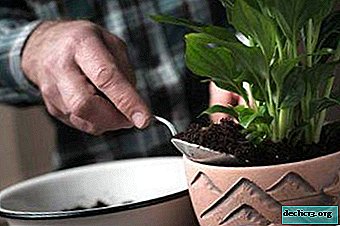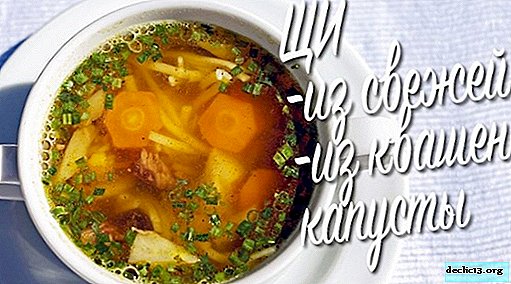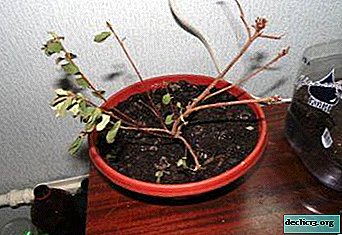All about when spathiphyllum is transplanted and how to do it correctly

Seeing the spathiphyllum in the shop windows, not many flower lovers pass by. It is quite difficult to refrain from buying, because the plant has lush foliage and original inflorescences.
For good flowering in the home, the apartment does not need to forget about transplanting. This process is of no small importance at different stages of plant development. When is it better to do this, is it possible to disturb a flowering plant and how often you can transplant you will learn from the article below.
When can soil replacement be done at home?
A transplant is a change of soil, sometimes updating a flower pot. Of course, the plant does not require monthly soil renewal. The first symptoms that spathiphyllum needs this procedure:
- if the plant sits tight enough in a flowerpot, it is difficult for young shoots to grow;
- the root system completely filled the entire space of the pot;
- brown roots, mold, fungal spores appear on the surface of the soil;
- stirring a socket in the ground;
- the soil has gone astray; there is no free air access;
- spathiphyllum does not bloom for a long time.
Usually the indoor flower is transplanted at certain times of the year.if nothing emergency happened. The best period for this is spring. It is then that the plant wakes up from winter sleep, ready for the active process of vegetation.
Reference! For transplantation, it is important to maintain the room temperature not lower than + 20 ° C, so as not to overcool the roots.In March-April, daylight increases, which is good, because the transplanted flower first needs intensive lighting. In addition, spring sunshine is not scorching, so a winter transplant is not advisable, especially in December.
Depending on the age of the plant
 In addition to the season when transplanting, the age of the spathiphyllum should also be taken into account. A young exot who is up to 3 years old is better to transplant every year. But an adult, transplanted annually, there is no need. It is enough to renew the soil once every 2-3 years.
In addition to the season when transplanting, the age of the spathiphyllum should also be taken into account. A young exot who is up to 3 years old is better to transplant every year. But an adult, transplanted annually, there is no need. It is enough to renew the soil once every 2-3 years.
As for the newly purchased flower, a transplant is necessary in this case (read about transplanting a newly purchased flower here). This is due to the cramped pot, poor-quality soil in which the plant was sold. But the process of changing the soil should not be performed immediately after purchase, but after 2-3 weeks. This time is necessary for adaptation.
Flower conditions
The reason for soil renewal is indoor flower disease or an attack of harmful insects. At the same time, you can notice that the plant changes its beautiful appearance:
- leaves lose turgor;
- the tips turn black or the leaf plate turns yellow;
- spots appear;
- signs rotted on the ground in a flowerpot.
When extracting exotics from a container, visual damage to the root system is noticeable. In this case, a spathiphyllum transplant should be performed.
- Remove damaged root areas.
- Treat slices with an antiseptic.
- Apply fungicide drugs to treat diseases.
- Change pot and soil.
If the condition of the plant deviates from the norm, and upon external inspection, small bugs are covered on the underside of the leaf - this is an occasion for changing the earthen mixture in the pot. After all when a plant is affected by harmful insects, the soil mixture is also affected.
Is it possible to disturb the blooming feminine happiness?
Changing the soil during flowering is extremely undesirable. Because the flower gives all the nutrients to the development of buds, and there will be no power left to recover. As a result, the following consequences arise:
- blackening inflorescence;
- yellow tips of foliage;
- withering of the lower leaves;
- shedding of buds.
It is also likely that flowering will completely stop. It’s best to wait until the satyphyllum blooms.
But if you can’t postpone the transplant, you can tranship. Plants tolerate a similar procedure, because the earth is not removed from the roots.
Urgent change of soil
It happens that, despite all the prohibitions, the plant requires an urgent change of soil. This happens if:
 the old roots stick out, the flower is disastrously small in the pot;
the old roots stick out, the flower is disastrously small in the pot;- the flower is damaged by parasites;
- a newly purchased flower has begun to fade;
- spathiphyllum is infected with fungal or bacterial infections;
- an excess of mineral fertilizers;
- waterlogged soil.
If after the measures taken to cure the plant did not work, it is worth updating the soil. Even if the plant is blooming. Then carefully remove the peduncles, leaving hemp 1-1.5 cm, which will give strength to adaptation.
How often is the procedure necessary?
Fans of this type of plant recommend frequent transplants. An indoor flower is transplanted up to three years annually, since it is actively growing. Further, it is enough for an adult exotica to change the soil once every 3-5 years.
Attention! It is preferable to contain spathiphyllum in a pot with a diameter of not more than 30-35 cm.Land must be updated. Because over time, it is depleted, the roots lack nutrients. Also, the structure becomes solid, dense, as a rule, natural processes in the soil are disturbed. Air does not enter, moisture is retained for a long time, causing rotting of the roots. Even in the soil, salts and other impurities are deposited, which appeared when using low-quality water for irrigation.
So, to summarize, spathiphyllum requires a periodic transplant. It is advisable to carry out in the spring season, after a period of rest, before active growth. And here, the flowering process mainly occurs in the summer. The procedure for changing the soil to perform carefully, the flower is fragile so as not to harm. Following the above recommendations, the plant will grow healthy, and bloom profusely, because nutrients will come from the renewed soil.

 the old roots stick out, the flower is disastrously small in the pot;
the old roots stick out, the flower is disastrously small in the pot;















